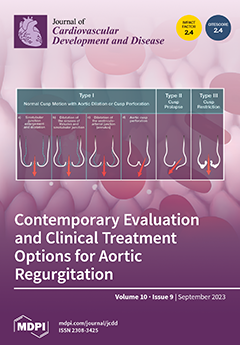A wide range of anti-myocardial autoantibodies have been reported since the 1970s. Among them, autoantibodies against the β
1-adrenergic receptor (β
1AR-AAb) have been the most thoroughly investigated, especially in dilated cardiomyopathy (DCM). Β
1AR-Aabs have agonist effects inducing desensitization
[...] Read more.
A wide range of anti-myocardial autoantibodies have been reported since the 1970s. Among them, autoantibodies against the β
1-adrenergic receptor (β
1AR-AAb) have been the most thoroughly investigated, especially in dilated cardiomyopathy (DCM). Β
1AR-Aabs have agonist effects inducing desensitization of β
1AR, cardiomyocyte apoptosis, and sustained calcium influx which lead to cardiac dysfunction and arrhythmias. Β
1AR-Aab has been reported to be detected in approximately 40% of patients with DCM, and the presence of the antibody has been associated with worse clinical outcomes. The removal of anti-myocardial autoantibodies including β
1AR-AAb by immunoadsorption is beneficial for the improvement of cardiac function for DCM patients. However, several studies have suggested that its efficacy depended on the removal of AAbs belonging to the IgG3 subclass, not total IgG. IgG subclasses differ in the structure of the Fc region, suggesting that the mechanism of action of β
1AR-AAb differs depending on the IgG subclasses. Our previous clinical research demonstrated that the patients with β
1AR-AAb better responded to β-blocker therapy, but the following studies found that its response also differed among IgG subclasses. Further studies are needed to elucidate the possible pathogenic role of IgG subclasses of β1AR-AAbs in DCM, and the broad spectrum of cardiovascular diseases including HF with preserved ejection fraction.
Full article






